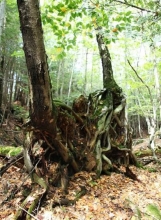You are here
Pits and Mounds: Diminished Elements in a Second-Growth Landscape

Pits and mounds might be considered the charismatic microtopography of the forest. These features, vividly nicknamed 'pillows and cradles,' are formed by the uprooting of trees. In most forests, these features contribute important habitat diversity while varying soil processes. A new study in the journal Forest Ecology & Management, led by HF senior scientist Audrey Barker Plotkin shows how pits and mounds differ in stature and function in old-growth versus second-growth forest.
The history of forest clearance for agriculture and repeated logging of the rest of New England forest erased many pits and mounds from the landscape. The smaller size of trees in second-growth forest now limits the stature of new pits and mounds.
The new study pulls together a summer research project by former HF student Bennet Leon, the doctoral thesis of Peter Schoonmaker, and Barker Plotkin and David Foster's long-term work to compare pit and mound structure and function at the HF hurricane pulldown experiment (second-growth forest) and at the Harvard Pisgah tract, an old-growth forest forest that was blown down by a hurricane in 1938.
A rare set of repeated measurements of 100 individual pit-mound structures in the pulldown documented the pace and pattern of mound and pit erosion over 25 years. Although 40% of mounds in the pulldown were 1-3 m tall immediately after the simulated hurricane, after 25 years maximum mound height was 0.9 m. In contrast, some mounds at Pisgah remained >2 m tall 50 years after the 1938 hurricane.
And although sun-loving tree saplings – such as birches – were disproportionately found on mounds in both forests, mounds may be a more important habitat feature in old-growth forests because niches for early successional species are few in these old forests but common in second-growth forests.
The authors note that foresters and landowners interested in restoring old-growth characteristics can protect and enhance pit-mound features, and cultivate large-diameter trees that will eventually create the large, long-lasting pit-mounds of the future.
- Read the full paper in Forest Ecology & Management: Microtopography and ecology of pit-mound structures in second-growth versus old-growth forests
(Photo of birches growing on a windthrown root mound, by David Foster)

